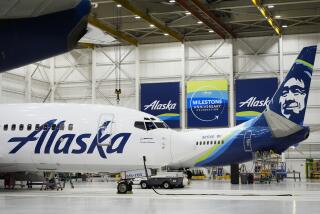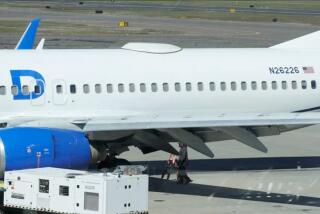Extra Safety Inspections Added : Evidence Lacking on How Jet Door May Have Failed
- Share via
HONOLULU — Federal investigators continued to focus on the apparent failure of a cargo door on a United Airlines Boeing 747 but conceded that they still have no hard evidence as to how that door might have malfunctioned, causing it to rip loose in the air near Hawaii and hurl nine people to their deaths.
However, Lee V. Dickinson, a member of the National Transportation Safety Board, told a nighttime press conference that the door was closed and latched electrically before takeoff from Honolulu International Airport in “what appeared to be a normal operation.
“There was nothing abnormal or unusual.”
Dickinson said cockpit instruments indicated that the door was properly latched before takeoff.
The missing door, probably the single most important piece of evidence, fell in 15,000 feet of water and probably never will be found, authorities said.
Clasps Also Missing
Missing along with the door are eight claw-like clasps that fit eight locking pins at the bottom of the 10-by-10-foot cargo door housing.
Dickinson said the locking pins showed evidence of scoring, or deep scratching, but whether that was caused by the ripping of the door away from the craft or by normal wear and tear was unknown.
The cargo doors are sealed by a member of the ground crew who flips a toggle switch on the outside of the plane, Dickinson said.
After all the clasps and latches are closed, the ground crew member shoves a lever, also on the outside of the craft, which closes the two pressure-release doors, or vents, in the cargo area so it can be pressurized. At the same time, the procedure locks the door. When the process is completed, a light in the flight crew’s compartment should go out.
The light worked properly Friday, Dickinson said.
Despite the missing door and the still unanswered questions concerning it, Dickinson said Sunday that he hoped that investigators will be able to determine what caused the malfunction on Flight 811 at 20,000 feet.
Special Maintenance Checks
Earlier Sunday, United Airlines began special maintenance checks on its entire fleet.
The maintenance inspections, described as “over and above” routine airline procedures and those required by the Federal Aviation Administration, include examination of the cargo doors on each of the 405 aircraft. United said the cargo doors on its 31 Boeing 747s already had been checked and found to be in working order.
United also said that an FAA-licensed mechanic will inspect each cargo door upon a 747’s arrival at a destination, in addition to regular pre-departure inspections, and that an FAA-licensed mechanic will oversee the closing of each 747 cargo door before departure. The door closings had been handled by “trained ramp service personnel,” the airline said.
“By announcing these steps, we want to make clear that we are not speculating and will not speculate on the cause of Friday’s incident,” Stephen M. Wolf, United Airlines chairman and chief executive, said. He said the inspections signified the airline’s “absolute commitment to safety.”
27 Others Injured
Flight 811 was bound for Auckland, New Zealand, with 357 people on board. In addition to the nine passengers who were forced out of the jumbo jet in the sudden decompression, 27 others were injured.
The U. S. Coast Guard in Hawaii called off a search for bodies and wreckage at noon Saturday.
“All units were recalled and we don’t anticipate any active search into the flight mishap, pending further developments,” Lt. David Littlejohn said.
He said that since the discovery Friday of a 4-by-6-foot metal piece--believed to be from either the door or the fuselage--nothing significant had been found.
About 2 a.m. Sunday, a load of debris collected at sea was brought to the Coast Guard station at Sand Island in the Honolulu area. Littlejohn said a second load of debris, containing “miscellaneous pieces . . . that might be associated with the mishap” arrived there Sunday night.
There was no indication that any human remains were recovered, Littlejohn said.
After an examination of the 57 pieces of floating debris brought to the Coast Guard station, nothing showed evidence of a bomb aboard the jumbo jet, the FBI said Sunday, adding that it will disengage itself from the case today.
Pressure Possibility Studied
In addition to the theory that the cargo door somehow opened slightly, and then was torn off by the force of a 500-m.p.h. slipstream that rushed over the aircraft as it flew through the sky, NTSB investigators are known to be exploring another line of reasoning--that the hole in the aircraft was caused when higher air pressure inside the plane blew the door open.
Last July, the Federal Aviation Administration ordered airlines to reinforce the cargo doors of certain Boeing 747s after a cargo door came open partially in flight. The airlines were given until December, 1989, to install steel plates to reinforce the door locks.
The FAA said that airlines could have more time--until July, 1990--to install the steel plates if a door had already been reinforced with aluminum plates. The FAA required ground crews to check all unreinforced cargo doors before each flight to make sure they were locked properly.
United said the cargo door on the Boeing 747 in the accident last week had been reinforced with aluminum plates. United and the FAA said the airline had complied with the initial portion of the FAA directive, that requiring visual inspections by ground crews.
United had inspected all 25 of its jets in the model series covered by the order, but by last week had completed the required modifications on just six planes. The plane in Friday’s accident was not one of those six.
Eric Malnic reported from Honolulu and Denise Gellene from Los Angeles. Staff writer Patt Morrison also contributed to this story.
FOCUS OF INVESTIGATION The gaping hole that blew open in the side of a United Airlines Boeing 747 near Hawaii Friday may have been caused by the failure of a cargo door. Nine passengers were hurled to their deaths from the break in the aircraft’s fuselage.
Investigators are seeking the precise cause of the tragedy.
Michael Marx, senior metallurgist for the National Transportation Safety Board, said there was no indication of extraordinary pressure or weight load on the cargo door, but added by way of a possible explanation: “Did you ever bust a balloon” by blowing it up over and over again?
More to Read
Sign up for Essential California
The most important California stories and recommendations in your inbox every morning.
You may occasionally receive promotional content from the Los Angeles Times.










